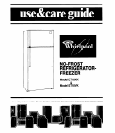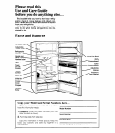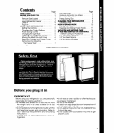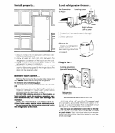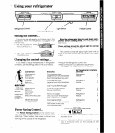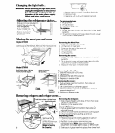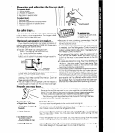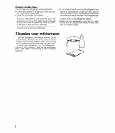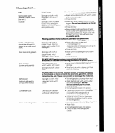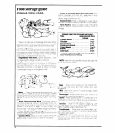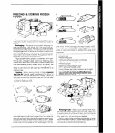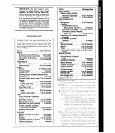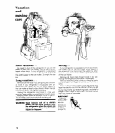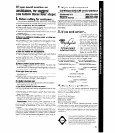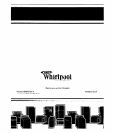
Removing and adjusting the freezer shelf...
To remove shelf:
1. Lift front slightly
2. Loft bock off supports.
3 Replace in reverse order.
To adjust shelf:
1 Remove shelf
2. Remove supports by sliding upwards
3. Replace supports on desired level.
4. Replace shelf.
Ice cube trays...
If cubes are not used, they may shrink. The moving
cold air starts a slow evaporation The longer cubes
are stored. the smaller they get.
To remove ice:
1. Hold tray at both ends.
2. Slightly twist.
Optional automatic ice maker.. .
l
Because of new plumbing connections, the first
If you have the automatic ice maker accessory or
ice may be discolored or off-flavored. Discard the
first few batches of ice.
plan to odd one later (Part No. ECKMF-83). there are a
few things you will want to know:
l
If ice is not being made fast enough and more ice
is needed, turn the Refrigerator Control toward a
l
The ON /OFF lever is a wire signal arm.
Down.. .for making ice automatically.
higher number. Wait a day and, If necessary. turn
the Freezer Control toward A.
Up.. .to shut off the ice maker
l
Shake the bin occasionally to keep cubes sepa-
l
If you remove the ice bin, raise the signal arm to
rated, and to obtain increased storage capacity.
shut off the ice maker. When you return the bin,
On
push it all the way in and lower the arm to the ON
positlon.
l
If cubes are stored too long, they may develop an
off-flavor...like stale water. Throw them away. They
will be replaced. Cubes in the ice bin can alS0
become smaller by evaporation.
ROIS~ Slgnal
Stop Ice
Maker
l
Good water quality is important for good ice quality.
It is not recommended that the ice maker be con-
. lt iS normal for ice crescents to be attached by a
netted to a softened water supply, Water softener
corner. They will break apart easily.
chemicals such as salt from a malfunctioning soft-
* YOU WIII hear water running when ice maker is
ener can damage the ice maker mold and lead to
working. You’ll hear ice fall into the bin Don’t let
poor quality ice. If a softened water supply cannot
these sounds bother you.
be avoided, then it is important that the water soft-
* The ice maker WIII not operate until the freezer is
ener be well maintained and operating properly
cold enough to make ice. This can take overnight.
Sounds you may hear...
3
‘5
Your new refrigerator may make sounds that your old one didn’t.
P
Because the sounds are new to you. you might be concerned about
’ ,F
them. Don’t be. Most of the new sounds are normal. Hard surfaces like
the floor, walls and cabinets can make the sounds seem louder.
The following chart describes the kinds of sounds that might be new
to you. and what may be maklng them.
Possible Sounds:
Probable Causes:
l
Slight Hum, Soft Hiss:
You may hear the refrigerator’s fan motor and moving air.
l
Clicking or Snapping
The defrosl timer makes a definite click when the refrigerator stops running. It
Sounds:
also makes a sound when the refrigerator starts.
l
Water Sounds:
When the refrigerator stops running. you may hear gurgling in the tubing for a
few minutes after It stops. You may also hear defrost water running into the
defrost water pan.
l
Ice Maker Sounds:
-trickling water
-thud (clatter of ice)
If your refrigerator has an ice maker, you may hear buzzing (from the water
valve], trickling water and the clatter of ice dumped into the bin.
l
Running Sounds:
Your refrigerator has a high-efficiency compressor and motor. It will run longer
than older designs. It may even seem to run most of the time.
7



